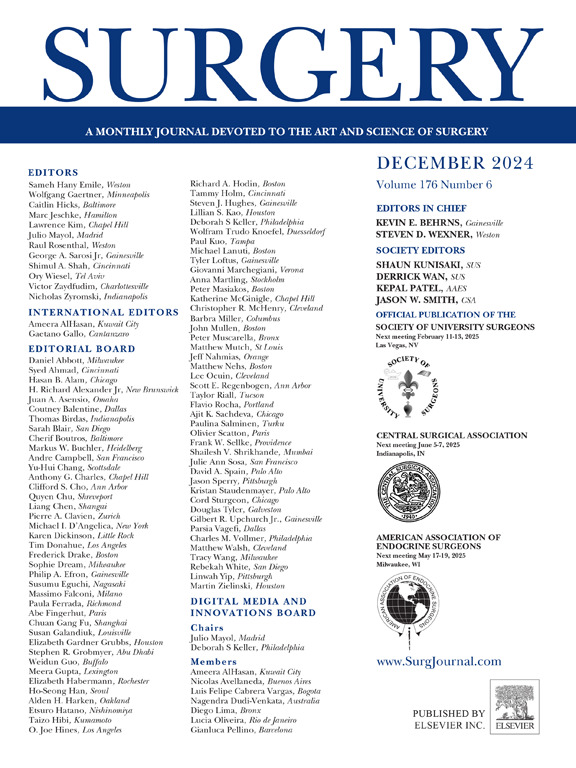在成功进行筋膜闭合的腹壁重建中,缺损大小是否重要?
IF 3.2
2区 医学
Q1 SURGERY
引用次数: 0
摘要
背景:相互矛盾的文献表明,腹壁重建中较大的缺损既会增加复发风险,也不会影响复发。在我们之前的研究中,缺损面积≥100 平方厘米的疝与不适感、手术时间和住院时间增加有关,但与复发或再次手术无关。我们的目标是确定即使是巨大的疝气,其缺损面积是否会影响完全筋膜闭合的网片修复术后的复发:方法:我们对一个前瞻性维护的疝气数据库进行了审查,该数据库中的患者都是采用筋膜闭合和合成网片进行腹壁重建的清洁患者。按缺损面积对患者进行分组和比较:中度疝气 2(LT200)和巨大疝气≥200 平方厘米(GT200):在 984 例患者中,607 例 LT200(平均面积:92.8 ± 60.8 cm2)与 377 例 GT200(平均面积:363.2 ± 196.7 cm2)进行了比较。LT200 和 GT200 的平均年龄、体重指数和吸烟率相似,但 GT200 的糖尿病(22.1% vs 27.9%;P = .040)、复发性疝(52.7% vs 63.4%;P = .001)、术前肉毒杆菌(0.7% vs 8.8%;P < .001)、组件分离(23.4% vs 59.9%;P < .001)、脓肿切除术(8.7% vs 15.4%;P = .001)和负压切口真空放置(5.9% vs 13.5%;P < .001)。GT200 增加了网片尺寸(753.5 ± 367.1 vs 1168.2 ± 412.0 平方厘米;P < .001)、手术时间(147.8 ± 55.7 vs 205.3 ± 59.9 分钟;P < .001)和住院时间(5.1 ± 3.2 vs 6.9 ± 4.4 天;P < .001)。GT200的伤口并发症(24.7% vs 36.1%;P < .001)和再住院率(9.1% vs 15.1%;P = .004)更高,但在LT200和GT200分别为30.1 ± 38.9个月和23.0 ± 33.6个月的平均随访期间,复发率(3.0% vs 3.7%;P = .520)相似。在多变量回归中,既往腹壁重建、轻质网片和伤口并发症可独立预测复发;组件分离具有保护作用,但缺损大小不能预测复发:结论:GT200需要更复杂的措施来实现筋膜闭合,并导致住院时间、伤口并发症和再入院率的增加;然而,当实现筋膜闭合时,GT200的复发率与较小的缺损相同。本文章由计算机程序翻译,如有差异,请以英文原文为准。
Does defect size matter in abdominal wall reconstruction with successful fascial closure?
Background
Conflicting literature suggests that larger defects in abdominal wall reconstruction both increase the risk of recurrence and have no impact on recurrence. In our prior work, hernias with defect areas ≥100 cm2 were associated with increased discomfort, operative time, and length of stay but not recurrence or reoperation. Our goal was to determine if defect size, even in giant hernias, would impact recurrence after mesh repair with complete fascial closure.
Methods
A prospectively maintained hernia database was reviewed for clean, abdominal wall reconstruction with fascial closure and synthetic mesh. Patients were grouped and compared by defect area: moderate hernias <200 cm2 (LT200) and giant hernias ≥200 cm2 (GT200).
Results
Of 984 patients, 607 LT200 (average area: 92.8 ± 60.8 cm2) were compared with 377 GT200 (average area: 363.2 ± 196.7 cm2). LT200 and GT200 had similar mean age, body mass index, and smoking rate, but GT200 had higher rates of diabetes (22.1% vs 27.9%; P = .040), recurrent hernias (52.7% vs 63.4%; P = .001), preoperative Botox (0.7% vs 8.8%; P < .001), component separation (23.4% vs 59.9%; P < .001), panniculectomy (8.7% vs 15.4%; P = .001), and negative-pressure incisional vacuum placement (5.9% vs 13.5%; P < .001). GT200 had increased mesh size (753.5 ± 367.1 vs 1168.2 ± 412.0 cm2; P < .001), operative time (147.8 ± 55.7 vs 205.3 ± 59.9 minutes; P < .001), and length of stay (5.1 ± 3.2 vs 6.9 ± 4.4 days; P < .001). GT200 had more wound complications (24.7% vs 36.1%; P < .001) and readmissions (9.1% vs 15.1%; P = .004) but similar recurrence rates (3.0% vs 3.7%; P = .520) over the mean follow-up of 30.1 ± 38.9 and 23.0 ± 33.6 months for LT200 and GT200, respectively. On multivariable regression, previous abdominal wall reconstruction, lightweight mesh, and wound complications independently predicted recurrence; component separation was protective, but defect size was not predictive of recurrence.
Conclusion
GT200 required more complex measures to achieve fascial closure and resulted in increased length of stay, wound complications, and readmissions; however, GT200 had the same recurrence rate as smaller defects when fascial closure was achieved.
求助全文
通过发布文献求助,成功后即可免费获取论文全文。
去求助
来源期刊

Surgery
医学-外科
CiteScore
5.40
自引率
5.30%
发文量
687
审稿时长
64 days
期刊介绍:
For 66 years, Surgery has published practical, authoritative information about procedures, clinical advances, and major trends shaping general surgery. Each issue features original scientific contributions and clinical reports. Peer-reviewed articles cover topics in oncology, trauma, gastrointestinal, vascular, and transplantation surgery. The journal also publishes papers from the meetings of its sponsoring societies, the Society of University Surgeons, the Central Surgical Association, and the American Association of Endocrine Surgeons.
 求助内容:
求助内容: 应助结果提醒方式:
应助结果提醒方式:


